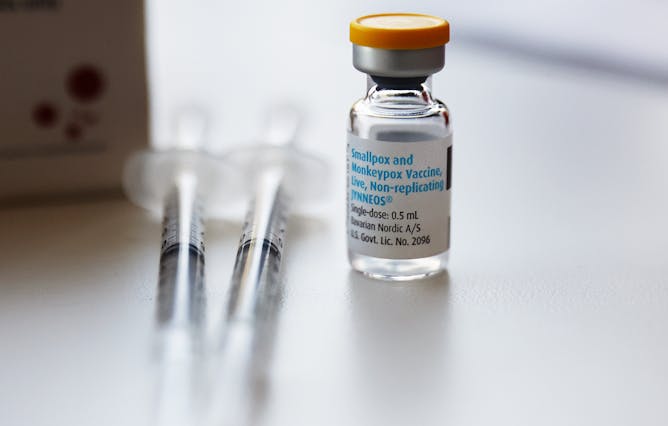|
Yesterday, the Biden administration declared monkeypox a national public health emergency. Another virus, another federal state of emergency and another reason to pay way more attention to vaccines than I ever thought I’d need to. Thankfully, monkeypox isn’t nearly as contagious or as deadly as COVID-19. But there is another important difference between the early days of the COVID-19 pandemic and where the U.S. is today with regard to monkeypox: There are already two vaccines approved for use against the virus.
Maureen Ferran is a virologist and infectious disease researcher at the Rochester Institute of Technology. She has been one of The Conversation’s go-to experts on coronavirus vaccines, so when it became clear that vaccination was going to be an important part of the monkeypox story, I could think of no one better to explain how these vaccines work, how protective they are and what is happening with the supply.
Also today:
|

|
Daniel Merino
Associate Breaking News Editor and Co-Host of The Conversation Weekly Podcast
|
|

The Jynneos monkeypox vaccine provides strong protection against infection but is in short supply.
Mario Tama/Getty Images
Maureen Ferran, Rochester Institute of Technology
There are two approved monkeypox vaccines in the US. Both use a related poxvirus called vaccinia to produce an immune response that protects against smallpox and monkeypox.
|
Politics + Society
|
-
William E. Butler, Penn State
US basketball star was handed a nine-year sentence after being found in possession of cannabis oil. By Western standards, that may seem severe, but it is in line with Russian jurisprudence.
-
Anthony Kammas, University of Southern California
The word ‘neoliberal’ gets thrown around a lot, often with differing and even contradictory meanings. Here, a political economist explains the origins and evolution of this complex concept.
-
Stefan Schmitt, Florida International University
Other recent conflicts that resulted in war crimes allegations help explain how complex it will be to gather evidence of war crimes in Ukraine – and provide answers for families of victims of the war.
-
Todd Hall, University of Oxford
Beijing’s response to the visit by the US speaker has a lot do with internal Chinese politics.
-
Beena Sarwar, Emerson College
Many images from the Ukraine war are compelling and distressing depictions of the human costs of war.
|
|
Arts + Culture
|
-
Amanda Baughan, University of Washington
Dissociation can be a healthy part of cognitive functioning, provided it doesn’t get in the way of your goals.
|
|
Environment + Energy
|
-
Joel E. Correia, University of Florida
It’s more than moral posturing. Resolutions like this have a history of laying the foundation for effective treaties and national laws.
|
|
Ethics + Religion
|
-
Thomas E. Doyle, II, Texas State University
Policymakers often think of their decisions about nuclear weapons as moral, a nuclear ethicist explains – which is key to understanding their motives.
-
Samuel Perry, Baylor University
Distrust of government blended with strains of Christian fundamentalism can produce a violent form of Christian nationalism, a scholar explains.
|
|
Education
|
-
Cliff McKinney, Mississippi State University
In some regions of the country, mothers and fathers have different approaches than their counterparts in other regions.
|
|
Health + Medicine
|
-
Ranjith Ramasamy, University of Miami
As more younger, single men ask for one following the Supreme Court abortion decision, a urologist explains what to expect with a vasectomy.
|
|
From our international editions
|
|
|
|
The Conversation Quiz 🧠 |
|---|
In 1996, when Gallup first polled about same-sex marriage, what percentage of people supported its legalization?
- A. 5%
- B. 12%
- C. 27%
- D. 40%
Click here for the answer.
-
| | |
|
| |
| |
| |
| |
|
|